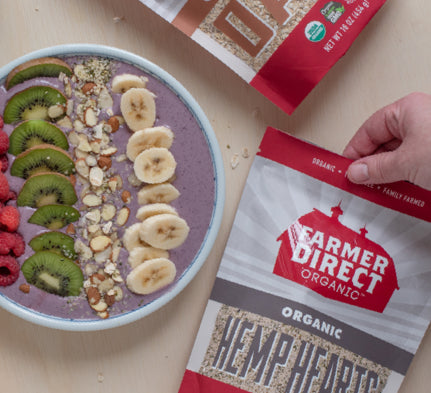Tested Clean
Organic certification standards have existed in North America for almost 20 years. That’s a strong foundation, one that farmers and consumers alike should celebrate! However, just as students don’t stop learning after graduation, we shouldn’t stop pursuing better quality, practices and transparency.
Working with Tested Clean, we have built greater transparency and vigilance into our efforts to help you avoid pesticides. For example, how can we know whether pesticide drift taints our lentils? How do we know whether our legumes were transported in trucks that held toxin-sprayed cattle feed? Health Research Institute (HRI) developed a certification called Tested Clean to help answer questions such as these, to give farmers and producers fundamental data, and to independently verify that the promises we make with organics are upheld.
 Tested Clean is a method of precisely measuring pesticide levels in food. It’s a program that tests every lot we produce before it gets to your family, and we’re proud to be early participants. How does it work? In addition to randomly testing our products by pulling them from grocery store shelves, HRI’s lab regularly receives samples of our grains, legumes, and seeds. The lab logs each product into a database using the same traceability number that we print on our packages. Scientists grind the product into a fine powder and use a solvent to extract chemicals like glyphosate and Aminomethylphosphonic acid (AMPA). Then they use a mass spectrometer to measure the amount of glyphosate and AMPA in the extract, and report the level of pesticide contamination in the original sample. Each lot that is tested must have pesticide levels below an extraordinarily low threshold – at least 90% lower than limits set by the USDA organic program and 99% lower than EPA standards. In other words, extraordinarily clean food!
Tested Clean is a method of precisely measuring pesticide levels in food. It’s a program that tests every lot we produce before it gets to your family, and we’re proud to be early participants. How does it work? In addition to randomly testing our products by pulling them from grocery store shelves, HRI’s lab regularly receives samples of our grains, legumes, and seeds. The lab logs each product into a database using the same traceability number that we print on our packages. Scientists grind the product into a fine powder and use a solvent to extract chemicals like glyphosate and Aminomethylphosphonic acid (AMPA). Then they use a mass spectrometer to measure the amount of glyphosate and AMPA in the extract, and report the level of pesticide contamination in the original sample. Each lot that is tested must have pesticide levels below an extraordinarily low threshold – at least 90% lower than limits set by the USDA organic program and 99% lower than EPA standards. In other words, extraordinarily clean food!So far, Farmer Direct Organic products have “come out quite clean and are sharply differentiated from conventional products,” according to HRI co-founder and Chief Scientist Dr. John Fagan. That’s not surprising, he said. What has surprised him, though, is that 1 in 15 organic-certified products his lab has tested have contained as much glyphosate as conventional products. Most of these instances have been products grown outside North America. Either pesticide drift from neighboring farms negates organic practices, or there are bad actors cheating the system.
Here’s the really exciting part. HRI is also developing a testing and certification system that will provide a comprehensive nutrient profile specific for each product. Farmer Direct Organic nutrient profiles will be far more precise than the estimates on Nutrition Facts labels.
Tested Clean is vital to our organic food future. It doesn’t replace certifications like USDA Organic. In fact, to even participate in Tested Clean, products must be certified organic first. Think of it this way: If organic certification is a practice-based standard, Tested Clean is a measurement of the success of those practices. As Dr. Fagan says, “If you can measure things, you can improve them.”
To learn more about Tested Clean, please visit the testedclean.org.
